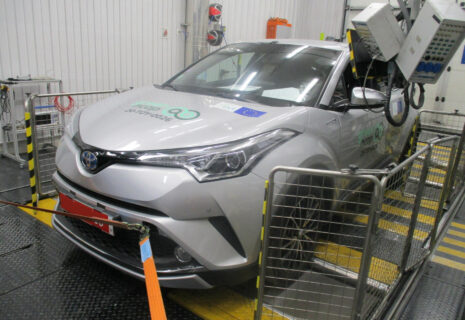Toyota C-HR 1.8 hybrid 4x2 automatic
2020
61%
6.0
10
Clean Air Index
6.9
10
Energy Efficiency Index
5.4
10
Greenhouse Gas Index
| Laboratory Tests | NMHC | NOX | NH3 | CO | PN | |
|---|---|---|---|---|---|---|
| 6.210 | Cold Test | |||||
| 7.810 | Warm Test | |||||
| 1.210 | Cold Ambient test | |||||
| 7.210 | Highway | |||||
| Road test | ||||||
| 6.810 | On-Road Drive | |||||
| 4.88 | On-Road Heavy Load | |||||
| 2.45 | On-Road Light Load | |||||
| 4.35 | On-Road Short Trip | |||||
| 2.02 | Congestion | |||||
| Robustness |
| Laboratory Tests | Energy | |||
|---|---|---|---|---|
| 8.110 | Cold Test | |||
| 8.910 | Warm Test | |||
| 6.010 | Cold Ambient test | |||
| 4.810 | Highway | |||
| Consumption | Driving Range | |||
| Average | 5.4l100 km | 839km | ||
| Worst-Case | 7.1l100 km | 608km | ||
| Greenhouse Gases | CO2 | N2O | CH4 | |
|---|---|---|---|---|
| 4.27 | Cold Test | |||
| 4.67 | Warm Test | |||
| 3.57 | Cold Ambient test | |||
| 3.07 | Highway |
Specifications
- Tested Car NMTKZ3BX00R18XXXX
- Publication Date 11 2020
- Vehicle Class Small SUV
- Emissions Class Euro 6d-Temp
- Tyres 225/50 R18
- Mass 1,429 kg
- Engine Size 1,798 cc
- Engine Power/Torque 72 kW/142 Nm
- Published CO2 111 g/km
- Declared battery capacity 1.25 kWh









































































































































Our verdict
The C-HR went on sale in 2017 with a choice of a 1.2 turbocharged petrol engine or 1.8 hybrid. A 2.0 hybrid was added in 2020 and, from 2021, the only the hybrid variants will be offered. The 1.8 hybrid, which comes only as 4x2 and with continuously variable transmission (CVT) is the version tested here. The car takes full advantage of Toyota's long-term commitment to hybrid technology, utilising it to good advantage in most situations. Fuel efficiency in the standard lab tests is very good and pollutant emissions are well controlled. The lack of a gasoline particulate filter (GPF) is regrettable as this would improve its performance even more. Green NCAP is informed that, from the end of 2020, a GPF is fitted to the C-HR. As tested, the C-HR delivers good, balanced scoring in all areas of assessment and the car emerges with a creditable 3½ star rating.